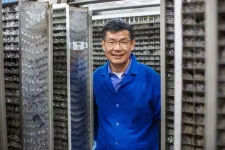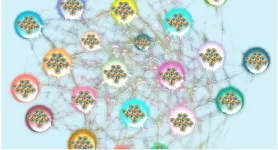(Press-News.org) University of Maryland researchers aiming to combat rising global temperatures have developed a new “cooling glass” that can turn down the heat indoors without electricity by drawing on the cold depths of space.
The new technology, a microporous glass coating described in a paper published in the journal Science, can lower the temperature of the material beneath it by 3.5 degrees Celsius at noon, and has the potential to reduce a mid-rise apartment building’s yearly carbon emissions by 10%, according to the research team led by Distinguished University Professor Liangbing Hu in the Department of Materials Science and Engineering.
The coating works in two ways: First, it reflects up to 99% of solar radiation to stop buildings from absorbing heat. More intriguingly, it emits heat in the form of longwave infrared radiation into the icy universe, where the temperature is generally around -270 degrees Celsius, or just a few degrees above absolute zero.
In a phenomenon known as “radiative cooling,” space effectively acts as a heat sink for the buildings; they take advantage of the new cooling glass design along with the so-called atmospheric transparency window—a part of the electromagnetic spectrum that passes through the atmosphere without boosting its temperature—to dump large amounts of heat into the infinite cold sky beyond. (The same phenomenon allows the earth to cool itself, particularly on clear nights, although with much less intense emissions than those from the new glass developed at UMD.)
“It’s a game-changing technology that simplifies how we keep buildings cool and energy-efficient,” said Assistant Research Scientist Xinpeng Zhao, the first author of the study. “This could change the way we live and help us take better care of our home and our planet."
[The Wood That Could—and Did—Receive a $20M Award: DoE Grant Supports Researcher’s Efforts to Introduce Ultra-strong Wood for Construction]
Unlike previous attempts at cooling coatings, the new UMD-developed glass is environmentally stable—able to withstand exposure to water, ultraviolet radiation, dirt and even flames, enduring temperatures of up to 1,000 degrees Celsius. The glass can be applied to a variety of surfaces like tile, brick and metal, making the technology highly scalable and adoptable for wide use.
The team used finely ground glass particles as a binder, allowing them to avoid polymers and enhance its long-term durability outdoors, Zhao said. And they chose the particle size to maximize emission of infrared heat while simultaneously reflecting sunlight.
The development of the cooling glass aligns with global efforts to cut energy consumption and fight climate change, said Hu, pointing to recent reports that this year’s Fourth of July fell on what may have been the hottest day globally in 125,000 years.
"This 'cooling glass' is more than a new material—it's a key part of the solution to climate change,” he said. “By cutting down on air conditioning use, we're taking big steps toward using less energy and reducing our carbon footprint. It shows how new technology can help us build a cooler, greener world."
Along with Hu and Zhao, mechanical engineering Professor Jelena Srebric and Professor Zongfu Yu from the Department of Electrical and Computer Engineering at the University of Wisconsin-Madison are co-authors of this study, contributing their expertise on building CO2 savings and structure design, respectively.
The team is now focusing on further testing and practical applications of their cooling glass. They are optimistic about its commercialization prospects and have created the startup company CeraCool to scale up and commercialize it.
END
UMD engineers’ ‘cooling glass’ blasts building heat into space
New coating can be applied to exterior surfaces to reduce AC use, fight climate change
2023-11-13
ELSE PRESS RELEASES FROM THIS DATE:
University of Oklahoma engineer elected as fellow member of Optica
2023-11-13
Optica, an international association in optics and photonics, recently announced the election of University of Oklahoma engineering professor Javier Jo, Ph.D., as a Fellow member.
Jo, a faculty member in the School of Electrical and Computer Engineering, was honored for his contributions to integrating optical imaging and artificial intelligence for biomedical applications. His research focuses on developing optical sensing and imaging technologies to understand pathophysiological mechanisms in human diseases and improve their clinical management.
“Dr. Jo’s ...
University of Toronto Engineering study finds bigger datasets might not always be better for AI models
2023-11-13
From ChatGPT to DALL-E, deep learning artificial intelligence (AI) algorithms are being applied to an ever-growing range of fields. A new study from University of Toronto Engineering researchers, published in Nature Communications, suggests that one of the fundamental assumptions of deep learning models — that they require enormous amounts of training data — may not be as solid as once thought.
Professor Jason Hattrick-Simpers and his team are focused on the design of next-generation materials, from catalysts that convert captured carbon into fuels to non-stick surfaces that keep airplane wings ice-free.
One ...
Acupuncture may offer limited relief to patients with chronic hives
2023-11-13
Annals of Internal Medicine Tip Sheet
@Annalsofim
Below please find summaries of new articles that will be published in the next issue of Annals of Internal Medicine. The summaries are not intended to substitute for the full articles as a source of information. This information is under strict embargo and by taking it into possession, media representatives are committing to the terms of the embargo not only on their own behalf, but also on behalf of the organization they represent.
----------------------------
1. Acupuncture may offer limited relief to patients with chronic hives
Abstract: https://www.acpjournals.org/doi/10.7326/M23-1043
Editorial: ...
Virologic rebound observed in 20% of patients treated with nirmatrelvir-ritonavir
2023-11-13
Embargoed for release until 5:00 p.m. ET on Monday 13 November 2023
Annals of Internal Medicine Tip Sheet
@Annalsofim
Below please find summaries of new articles that will be published in the next issue of Annals of Internal Medicine. The summaries are not intended to substitute for the full articles as a source of information. This information is under strict embargo and by taking it into possession, media representatives are committing to the terms of the embargo not only on their own behalf, but also on behalf ...
One in five patients experience rebound COVID after taking Paxlovid, new study finds
2023-11-13
A new study by investigators from Mass General Brigham found that one in five individuals taking Nirmatrelvir-ritonavir therapy, commonly known as Paxlovid, to treat severe symptoms of COVID-19, experienced a positive test result and shedding of live and potentially contagious virus following an initial recovery and negative test—a phenomenon known as virologic rebound. By contrast, people not taking Paxlovid only experienced rebound about 2 percent of the time. Results are published in Annals of Internal Medicine.
“We conducted this study to address lingering questions about Paxlovid and virologic rebound in COVID-19 treatment,” said corresponding ...
Scientists discover key to a potential natural cancer treatment’s potency
2023-11-13
JUPITER, Fla. — Slumbering among thousands of bacterial strains in a collection of natural specimens at The Herbert Wertheim UF Scripps Institute for Biomedical Innovation & Technology, several fragile vials held something unexpected, and possibly very useful.
Writing in the journal Nature Chemical Biology, a team led by chemist Ben Shen, Ph.D., described discovery of two new enzymes, ones with uniquely useful properties that could help in the fight against human diseases including cancer. The discovery, published ...
Mount Sinai researchers find more than 4,700 gene clusters crucial for prognosis in 32 cancer types
2023-11-13
New York, NY (November 13, 2023)—Researchers at the Mount Sinai Center for Transformative Disease Modeling have released a groundbreaking study identifying 4,749 key gene clusters, termed “prognostic modules,” that significantly influence the progression of 32 different types of cancer. The study, published in Genome Research, serves as a comprehensive resource and lays the foundation for the development of next-generation cancer treatments and diagnostic markers.
Despite significant progress in cancer research, understanding the disease's genetic intricacies ...
Ammonia fuel offers great benefits but demands careful action
2023-11-13
Ammonia, a main component of many fertilizers, could play a key role in a carbon-free fuel system as a convenient way to transport and store clean hydrogen. The chemical, made of hydrogen and nitrogen (NH3), can also itself be burned as a zero-carbon fuel. However, new research led by Princeton University illustrates that even though it may not be a source of carbon pollution, ammonia’s widespread use in the energy sector could pose a grave risk to the nitrogen cycle and climate without proper engineering precautions.
Publishing their findings in PNAS, the interdisciplinary team of 12 researchers found that a well-engineered ammonia economy could help the world achieve ...
Low-intensity fires reduce wildfire risk by 60%, study finds
2023-11-13
November 13, 2023-- There is no longer any question of how to prevent high-intensity, often catastrophic, wildfires that have become increasingly frequent across the Western U.S., according to a new study by researchers at Columbia University Mailman School of Public Health and Stanford University. The analysis reveals that low-intensity burning, such as controlled or prescribed fires, managed wildfires, and tribal cultural burning, can dramatically reduce the risk of devastating fires for years at a time. The findings are some of the first to rigorously quantify the value of low-intensity fire and be released while Congress is reassessing ...
Astrophysicist uses NSF funding to grow the number of deaf, hard-of-hearing, and Hispanic researchers
2023-11-13
Astrophysicist Jason Nordhaus is breaking cultural and disciplinary boundaries by helping to grow the number of deaf, hard-of-hearing, and Hispanic researchers. And, in doing so, he is enabling these future scientists to drive discoveries in one of his areas of expertise—neutron star astrophysics.
Nordhaus, an associate professor of physics at Rochester Institute of Technology’s National Technical Institute for the Deaf, has earned a National Science Foundation grant that connects NTID with Texas Tech University, a Hispanic Serving Institution. Through a series of unique summer research exchanges ...
LAST 30 PRESS RELEASES:
UVA’s Jundong Li wins ICDM’S 2025 Tao Li Award for data mining, machine learning
UVA’s low-power, high-performance computer power player Mircea Stan earns National Academy of Inventors fellowship
Not playing by the rules: USU researcher explores filamentous algae dynamics in rivers
Do our body clocks influence our risk of dementia?
Anthropologists offer new evidence of bipedalism in long-debated fossil discovery
Safer receipt paper from wood
Dosage-sensitive genes suggest no whole-genome duplications in ancestral angiosperm
First ancient human herpesvirus genomes document their deep history with humans
Why Some Bacteria Survive Antibiotics and How to Stop Them - New study reveals that bacteria can survive antibiotic treatment through two fundamentally different “shutdown modes”
UCLA study links scar healing to dangerous placenta condition
CHANGE-seq-BE finds off-target changes in the genome from base editors
The Journal of Nuclear Medicine Ahead-of-Print Tip Sheet: January 2, 2026
Delayed or absent first dose of measles, mumps, and rubella vaccination
Trends in US preterm birth rates by household income and race and ethnicity
Study identifies potential biomarker linked to progression and brain inflammation in multiple sclerosis
Many mothers in Norway do not show up for postnatal check-ups
Researchers want to find out why quick clay is so unstable
Superradiant spins show teamwork at the quantum scale
Cleveland Clinic Research links tumor bacteria to immunotherapy resistance in head and neck cancer
First Editorial of 2026: Resisting AI slop
Joint ground- and space-based observations reveal Saturn-mass rogue planet
Inheritable genetic variant offers protection against blood cancer risk and progression
Pigs settled Pacific islands alongside early human voyagers
A Coral reef’s daily pulse reshapes microbes in surrounding waters
EAST Tokamak experiments exceed plasma density limit, offering new approach to fusion ignition
Groundbreaking discovery reveals Africa’s oldest cremation pyre and complex ritual practices
First breathing ‘lung-on-chip’ developed using genetically identical cells
How people moved pigs across the Pacific
Interaction of climate change and human activity and its impact on plant diversity in Qinghai-Tibet plateau
From addressing uncertainty to national strategy: an interpretation of Professor Lim Siong Guan’s views
[Press-News.org] UMD engineers’ ‘cooling glass’ blasts building heat into spaceNew coating can be applied to exterior surfaces to reduce AC use, fight climate change


